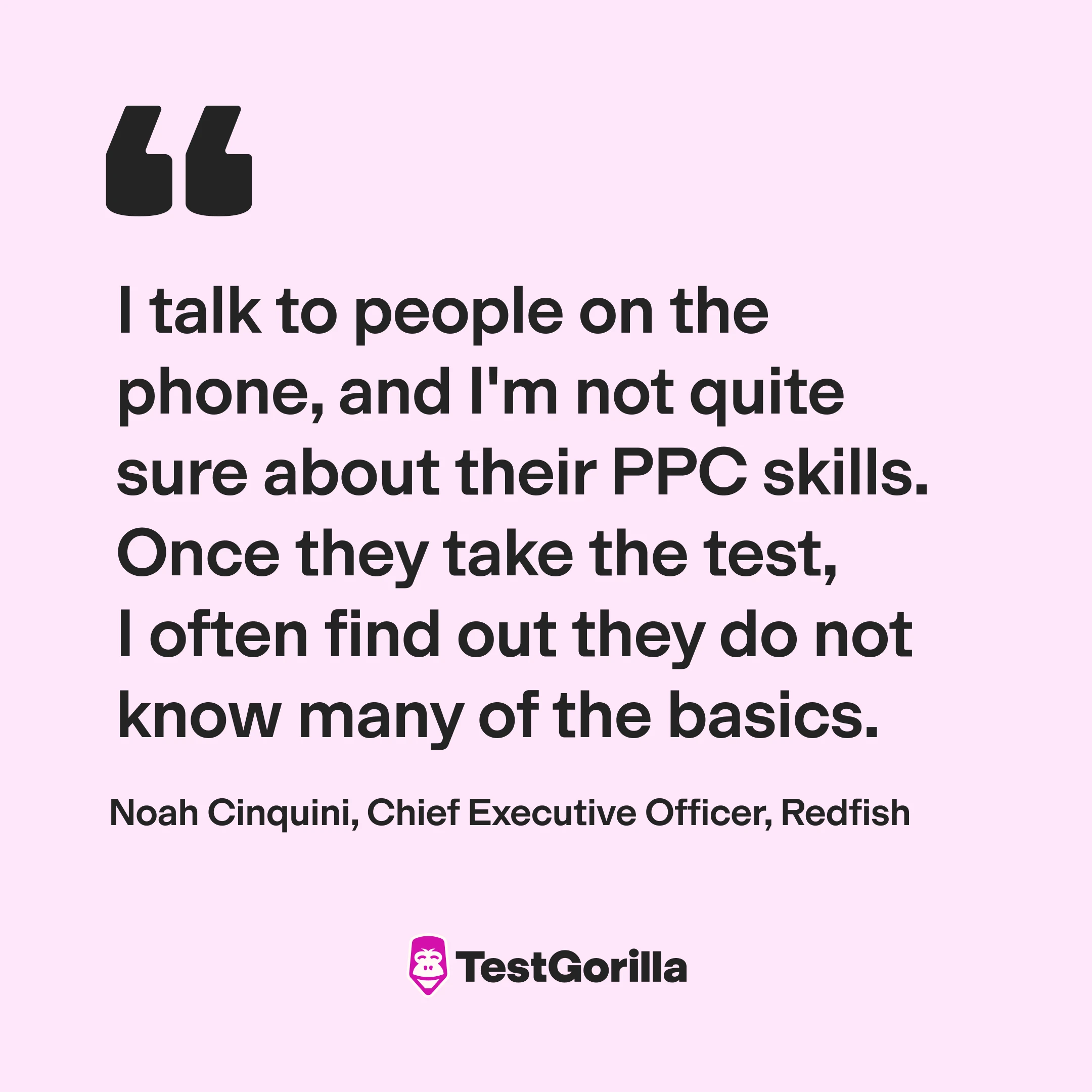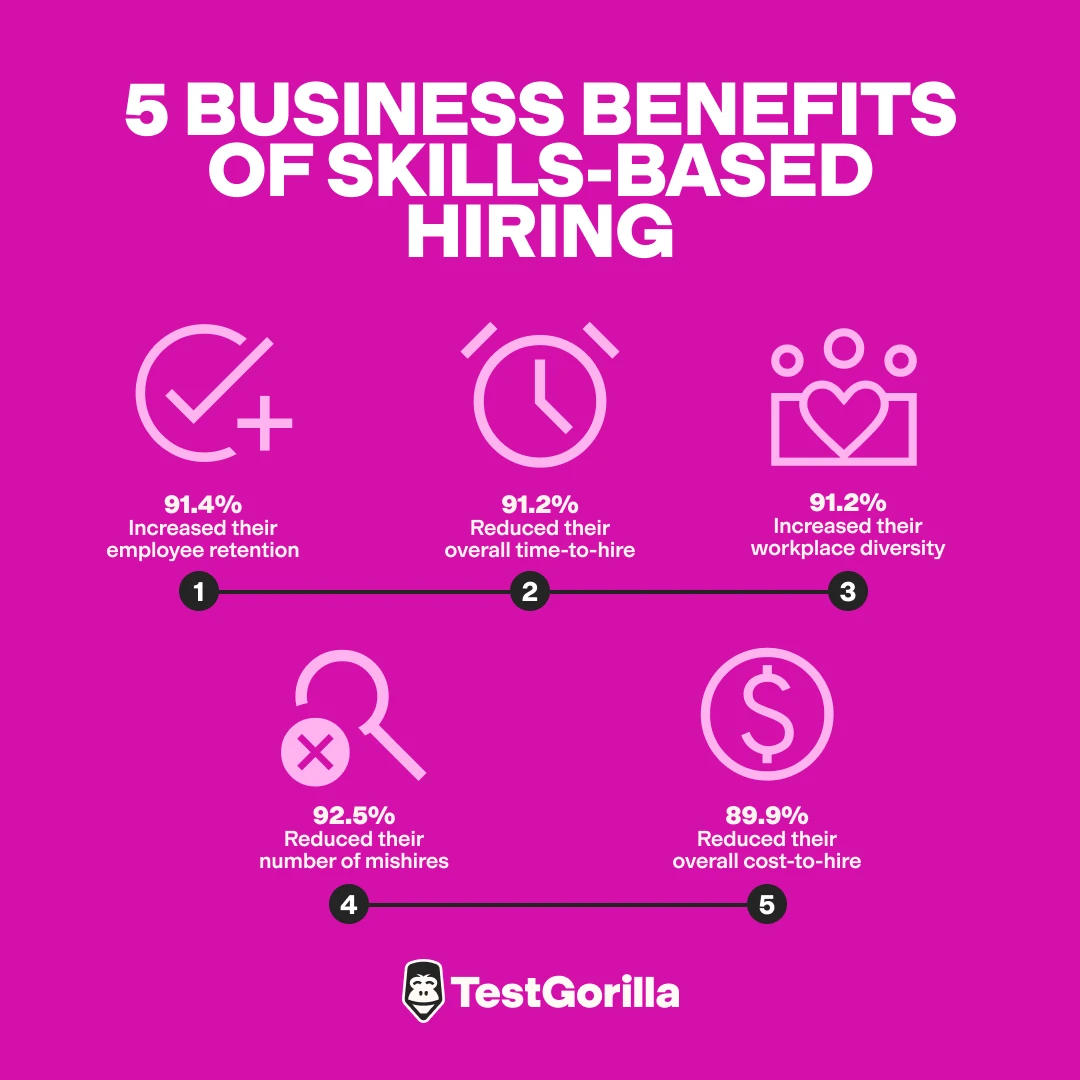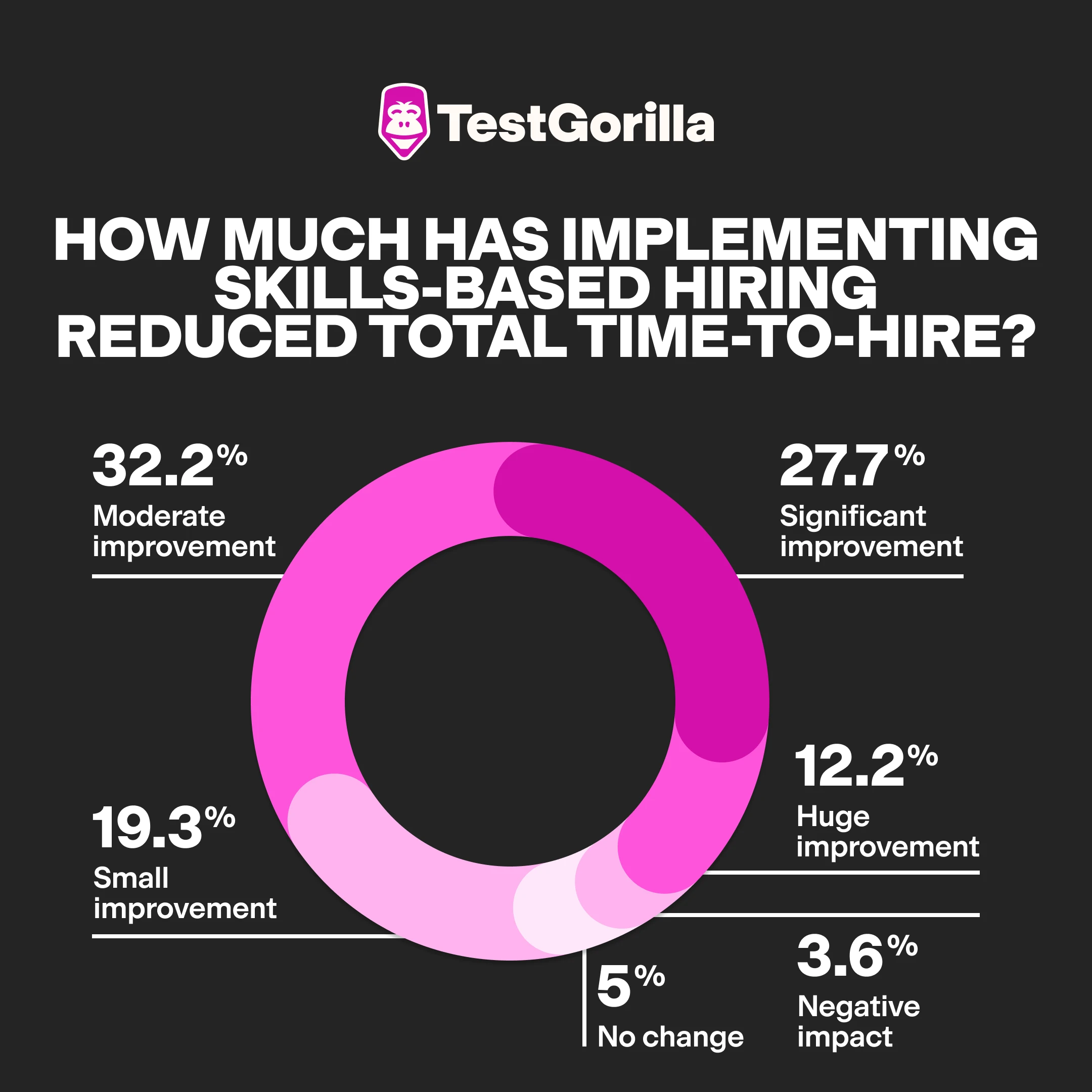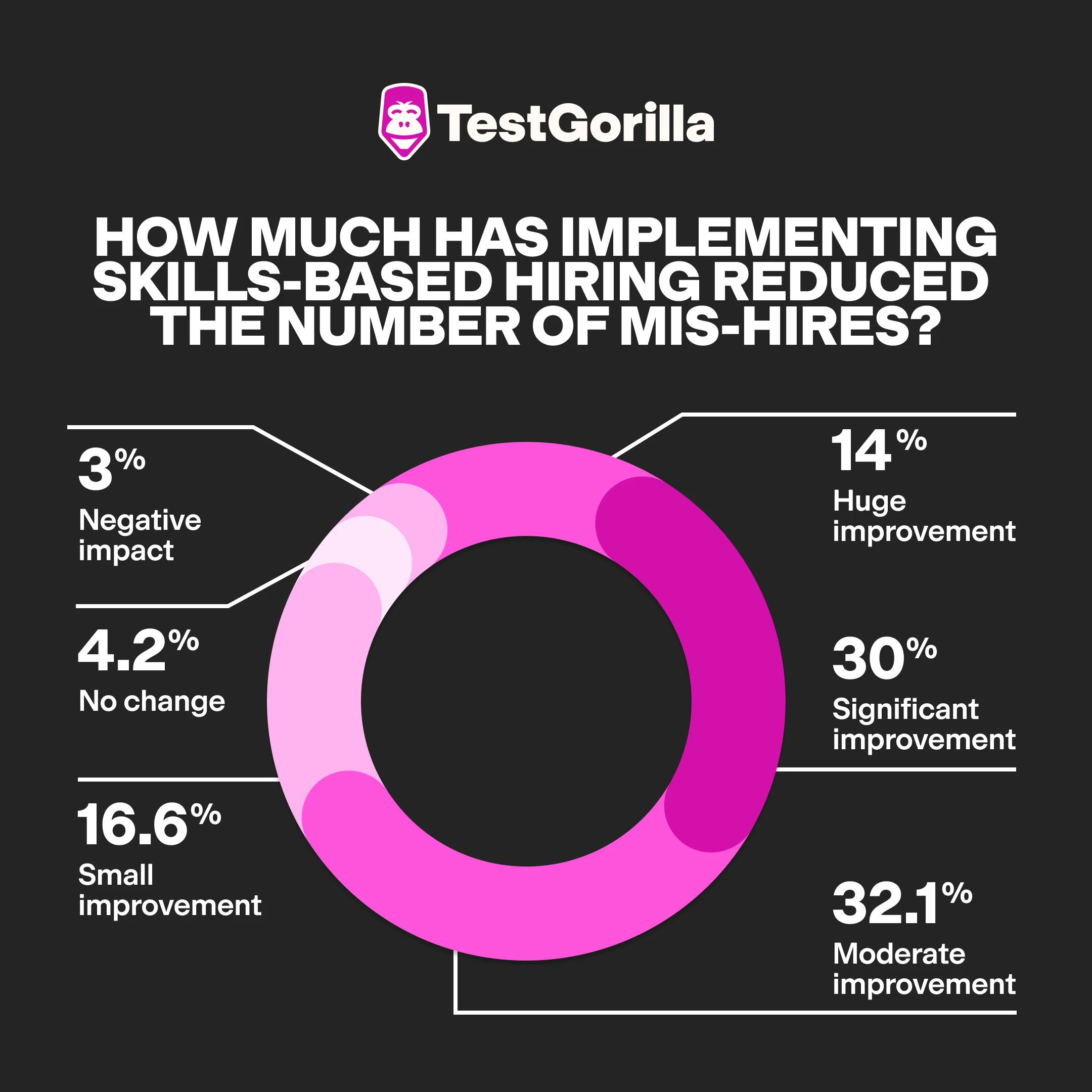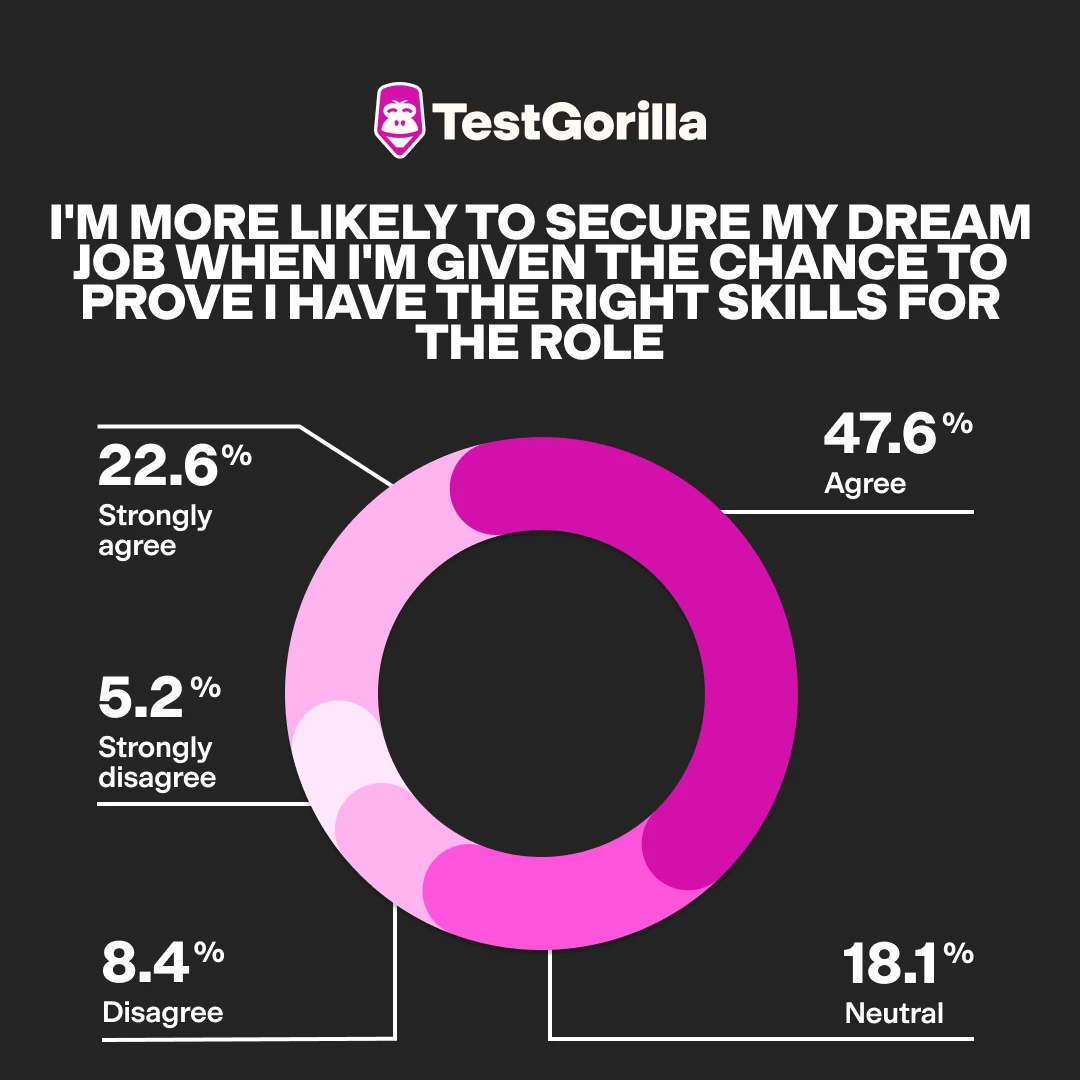Skills-based hiring requires hiring managers to break from traditional recruitment practices and adopt a new mindset. But as well as being a fairer way to identify and reward the right candidates – and spot the warning signs of a bad hire – it brings tangible business benefits to your organization.
Through accurate insights into how well a candidate’s skills match a particular role, employers can reduce hiring costs and build a more engaged and productive team.
In this article, we’ll explore the business benefits of employing people based on their ability with key findings from our State of Skills-Based Hiring report – and look at how companies can move to this model.
Table of contents
What is the cost of using a traditional approach to hiring?
The total cost to hire a new employee is usually three to four times a position’s salary. And beyond the obvious costs – from advertising job listings to using resume software – other expenses quickly add up.
In a traditional hiring process, recruiters look at work history and experience to see if a candidate is suitable for a role. This resume-focused approach has a number of issues:
32% of people say that they have lied on their resumes, so you cannot take them at face value.
A person’s experience and education don’t necessarily equate to suitability for a role. Skills (both hard and soft) can be a much better indicator of performance.
The time that departmental leaders and hiring managers usually spend finding the right candidates can account for between 30-40% of overall recruitment costs.
It results in high rates of mis-hires and low employee retention.
Recruitment biases prevent the most able candidates from getting access to roles.
What is skills-based hiring?
Skills-based hiring is a revolutionary new approach to recruitment in which candidates are evaluated based on their personality, cognitive abilities, role-specific skills, and soft skills rather than their experience or education.
In this methodology employers screen potential hires using tools such as skills assessments, structured interviews, and work samples. As a result, they are able to make accurate, objective, and bias-free hiring decisions based on the full range of talent job applicants bring to the table.
Why is skills-based hiring on the rise?
According to data from our State of Skills-Based Hiring report, 76% of employers are now using skills-based hiring practices.
Of these companies, 56% said that they made the decision to adopt this approach at some point over the past two years. A timeframe which happens to coincide with the onset of the Covid-19 pandemic and the resulting move to remote and hybrid workplaces.
As a number of roles that were previously considered essential in-office positions were reclassified as remote jobs, many organization reassessed their hiring strategies and expanded their recruitment to the global market where a wealth of previously untapped talent was available.
Unfortunately, screening international candidates based on their resumes was easier said than done.
While locally-based applicants were often judged based on the strength of their degree, the university they'd attended, and the reputation of organizations they'd worked at, hiring managers often lacked the context to judge remote applicants the same way. In other words, they were unable to make inferences about the suitability of a candidate based on resumes.
Skills-based hiring provided the perfect antidote to these challenges. It enabled companies to employ people based on their ability through an approach that could be applied in a standardized way across all countries. So, job applicants from every region would get an equal shot at proving their ability to succeed in the role.
Noah Cinquini, chief executive of marketing company, Redfish, says frequent mis-hires have been a drain on his agency’s time and money. After the company started employing people based on their ability rather than their experience or education, he has become more aware of how to avoid hiring bad employees.
“I talk to people on the phone, and I’m not quite sure about their PPC skills. Once they take the test, I often find out they do not know many of the basics,” Noah explains.
Since moving to a skills-based approach, Noah has been able to reinvest the resources he saved in expensive mis-hires back into the company, and concentrate on improving the business’s performance and services.
Let’s take a closer look at the business benefits of skills-based hiring.
5 ways skills-based hiring benefits your business
Skills-based hiring gives companies access to a wider, more diverse talent pool, and saves time and money during the recruitment process.
Data from our report shows that organizations that use this hiring method experience improvements across four key metrics:
Source: 2022 State of Skills-Based Hiring report
In addition, by assessing a person’s skills, rather than their education and experience, a business can attract better quality hires. The result: greater productivity and improved employee morale.
1. Reduction in total time-to-hire
Time-to-hire is the time between a candidate applying to join a company and accepting a job offer. It’s an important metric for hiring managers because it shows how quickly an organization can move applicants through its recruitment process.
Skills-based hiring facilitates a more efficient and streamlined hiring process. By sending candidates a link to skills-based tests before the interview stage, recruiters can quickly assess a candidate’s skills objectively and view their results in a dashboard.Of the companies we surveyed in our 2022 State of Skills-Based report, 91.4% reported a reduction in their total time-to-hire when using skills-based hiring. And 39.9% saw a fall of more than 25%.
Source: 2022 State of Skills-Based Hiring report
Environmental tech company Hydroemission was able to cut the time it took to assess applicants by 80% using skills-based hiring. Where once they relied heavily on face-to-face interviews, their process now looks like this:
The HR department posts a job ad. Then, collects and screens resumes.
After the head of department reviews applications, candidates receive an invitation to take a cognitive assessment and time management test.
Candidates who pass these two assessments receive a take-home assignment.
The successful candidate is invited to an in-person interview.
The result has been a faster, more efficient, and more reliable hiring process. And Hydroemission’s quality of hire has significantly improved.
2. Reduction in total cost-to-hire
According to the Society for Human Resource Management (SHRM), it costs more than $4,000 to fill an open role on average. Costs include internal and external recruiters, as well as advertising on job boards and careers pages, and creating and maintaining brand information about the business to attract candidates.
Investing in the best candidates is obviously worthwhile. But reducing these costs where possible is key to staying competitive as an organization.
Skills-based hiring can reduce the cost-to-hire by eliminating the need to:
Pay external recruiters to sift through candidates
Use resume screening software to filter candidates
Pay department leaders and hiring managers to assess candidates on their skills
In our 2022 State of Skills-Based report, 89.9% of companies identify a reduction in hiring expenses since adopting skills-based hiring, with 36.6% seeing a fall of more than 25%.
Source: 2022 State of Skills-Based Hiring report
Skills-based hiring also lets businesses widen their search, resulting in better hires, which will bring long-term benefits to an organization.
Achyut Menon, managing director of Options Executive Search, points out that the concept of cost-to-hire is an “industrial-era” concept. Instead, he says that companies in our current “intellectual era” should focus on the quality of hire.
There is a lot of difference between hires: you can find ‘a person’ or ‘the person’, and the right person will probably give you two or three times better solutions.
Achyut Menon, managing director of Options Executive Search
3. Reduction in mis-hires
Mis-hires occur when a business employs an unsuitable candidate for a role, and they end up leaving soon after appointment. This problem companies on average 30% of the employee’s annual compensation.
Beyond the costs of employee compensation and resuming the hiring process, a mis-hire can lead to disruption to team morale and productivity.
While there are unavoidable situations when employees leave their jobs early due to unexpected changes in circumstance, most mis-hires can be avoided by a well-trained HR team using the right recruitment tools.
Skills-based hiring makes the warning signs of a bad hire clear early on by replicating the experience of working in the role. With skills-based hiring software, employers can choose from a range of tests. You can check that candidates’ technical skills match your requirements. And you can test for culture add, which assesses how a candidate’s values and behaviors align with your organization.
Of the companies we surveyed, 92.5% have seen a reduction in their mis-hire rate using skills-based hiring. And 44% of these recorded a drop of more than 25%.
4. Improved team morale
The wrong hire can cause disruption to teams. Highly skilled staff want to work with other highly skilled staff. And it can be demoralizing if new team members join who require a lot of training or don’t do their share of the work.
Traditionally, organizations looked for people who would ‘fit in’ with other team members and preserve a sense of comfort and familiarity. But this approach excludes many skilled candidates with a different background from existing staff. While it encourages hiring managers to think about what a person is lacking, and not what they can bring to the table.
By aiming for culture add, organizations can look for people who value their standards and culture – but also bring something new and different.
Finding candidates who contribute positively to your teams is good for morale. And employees are more likely to be satisfied and bring a positive energy to work when they find a role that suits their skills.
Among the group of employees we surveyed, 72.1% of those hired using skills-based hiring were either happy or very happy in their current role, compared to 62.9% of those who were recruited via other methods.
Business travel management organization, TruTrip, switched to skills testing to avoid mis-hires that had cost it time and money – and negatively affected teamwork in the past.
As well as reducing reliance on resumes and eliminating bias from the recruitment process, the new method helped improve teamwork and communication and the employee experience of new hires.
“Our new hires appear to be a better fit. They become great contributors more quickly and, importantly, they appear to have a better initial experience with us.”
Hugh Batley, founder of business travel management organization, TruTrip
Source: 2022 State of Skills-Based Hiring report
5. Higher employee retention
You can measure employee retention by calculating the number of staff who stay in your company for a length of time (like a year) and show it as a percentage of total workforce.
You can use this metric to understand whether your business is selecting people who settle in well to their new roles and teams. Or if there’s a problem in the recruitment process that results in new hires leaving after a few weeks or months.
As well as paying the high cost of recruiting new staff, companies with low rates of employee retention need to understand the root causes of employee churn – like an unmotivating working environment – and try to fix them.
By testing candidates based on skills and culture fit, it’s more likely that you’ll find employees who stick with your company in the long term.
By identifying exactly which skills your employees hold, you can also help them to upskill and assist occupational mobility. As HR Analyst Ben Eubanks says, “candidates want to know that you have a plan as an employer beyond what you’re starting them into.” Showing a good awareness of their skills is a good indicator of this early on.
91.2% of the companies we surveyed have seen an increase in employee retention through the use of skills-based hiring. And 43.6% of these organizations noticed an improvement of more than 25%.
Source: 2022 State of Skills-Based Hiring report
Moving to a skills-based approach to hiring
Skills-based hiring can level the playing field, allowing employers to focus less on factors that can be exclusionary, such as educational status, and more on finding great team members they once may have overlooked.
When looking at examples of skills-based hiring, we can see that moving to skills-based hiring requires a shift in strategy. Companies start by looking in-depth at what really makes a qualified candidate, rather than outlining what a job will entail. They then need to create skill-based profiles for their job roles and find reliable ways to test early in the screening process.
One company that has moved to a skills-based approach is Google, which encourages candidates to first think about their own skills before considering job positions. Its advertisements make it easy for candidates to directly compare how their skills align and every candidate is tested on how well they fit with the company culture.
Our research shows that employees are willing to put up with extra or altered hiring steps if they improve fairness and their chances of securing a role. 55% of employees we spoke to said that they felt skills-based hiring enabled them to access career opportunities that would otherwise have been out of their reach.
We also found that 70.2% of respondents agree or strongly agree that these skills-based hiring practices increase the likelihood that they can secure their “dream jobs.”
Source: 2022 State of Skills-Based Hiring report
Transform your hiring practices: Start employing people based on their ability
Skills-based hiring is transforming the hiring process and, in turn, bottom lines. Through accurate insights into how well a candidate’s skills might match a particular role, employers can reduce recruitment costs and build a diverse team with a variety of skills and perspectives.
By providing insight into the warning signs of a bad hire, skills-based hiring can:
Reduce time-to-hire
Reduce cost-to-hire
Reduce mis-hires
Improve team morale
Increase employee retention
And in pinpointing people who may be a great fit both in terms of skills and culture, you can boost teams and morale. A skills-hired team will bring different ideas but be united by the same values, and work together more effectively.
Looking to reduce mis-hires and lower recruitment costs? Skills-based hiring helps you pinpoint exactly the right candidates for your roles. Download the report to learn more.
Related posts
Hire the best candidates with TestGorilla
Create pre-employment assessments in minutes to screen candidates, save time, and hire the best talent.
Latest posts
The best advice in pre-employment testing, in your inbox.
No spam. Unsubscribe at any time.

Hire the best. No bias. No stress.
Our screening tests identify the best candidates and make your hiring decisions faster, easier, and bias-free.
Free resources
This checklist covers key features you should look for when choosing a skills testing platform
This resource will help you develop an onboarding checklist for new hires.
How to assess your candidates' attention to detail.
Learn how to get human resources certified through HRCI or SHRM.
Learn how you can improve the level of talent at your company.
Learn how CapitalT reduced hiring bias with online skills assessments.
Learn how to make the resume process more efficient and more effective.
Improve your hiring strategy with these 7 critical recruitment metrics.
Learn how Sukhi decreased time spent reviewing resumes by 83%!
Hire more efficiently with these hacks that 99% of recruiters aren't using.
Make a business case for diversity and inclusion initiatives with this data.

